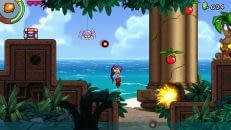Top 5 Pick-Up-And-Play Indie Games
Just as I imagine many of you readers are, I’m quite a busy person. As well as writing for IGM, I am a full-time student, and as such I have found my gaming time reduced. For me, tackling a 100 hour RPG hasn’t been a viable option for a while, so I’ve had to find more manageable ways of getting my gaming kicks. Of course, our Indie Intermission series does a great job of shining the spotlight on indie games which can be enjoyed in a limited amount of time. However, I have been wanting to compile a list of my personal favorites for a while now. Here it is, complete with some insight from the developers behind the games.
Of course, many of these smaller, bite-sized games are now appearing on mobile platforms, but that’s a topic for our sister site IGM Mobile to discuss. For now, here are 5 of my favorite pick-up-and-play indie games available for PC.
5. Super Bomb Drop DX
This is a game that started out on Android, and made a real impression on me. The game has now arrived on the PC platform, and is still brilliant despite being inferior to the mobile version. Super Bomb Drop DX is essentially a high score arcade game in which you improve through repetition. Incredibly basic, the game presents a series of colored squares flying from right to left of the screen, each color denoting a different points value and flying speed. Your task is to simply click to drop bombs, aiming to explode the high-scoring squares and avoid the red ones, which incur a 50 points penalty. Endlessly replayable, compulsively satisfying, dead cheap.
Note also that when I say inferior to the mobile version, I mean only in terms of controls. I personally preferred the immediacy of jabbing a touchscreen, but the control scheme on PC isn’t bad either. To cut a long story short, both versions are great. Get one or the other.
The developer says… “For me, for a game to be a ‘pick-up-and-play’ title, the aim is that within a few seconds of starting the game it must be clear to the player how they interact with it and the results of that should clearly communicate whether what they did was a good or bad thing.
“This doesn’t mean that the game has to be simplistic – you could introduce lots of varying elements or mechanics as the player progresses through the game but each individual element should always be introduced with this transparent cause-effect action in mind.
“The ‘how’ could be achieved by a one word instruction (“TAP!”) or an impossible-to-misinterpret visual (such as an animating arrow showing exactly how you interact) or even something more subtle in the colors or lighting on-screen to pull the player’s attention to a particular element.
“Once they know how to interact with the game then triggering an obvious result will communicate to the player whether what they did was the right/wrong thing to do to win the game. A visual and audio effect for each distinctive outcome is preferable so that players can easily differentiate between polar results. Its sometimes useful to think of yourself as a Director sometimes – I want the player to look at this area at this point in time so I need to do X to achieve that.
“My Minima series of games are purposefully limited to one mechanic and a minimal art style which I feel makes it relatively easy to achieve these aims. For example, they are all score or time-based games which allow me to add floating scores on target destruction or big red negative numbers for losing time. The minimal art choice was born of necessity rather than choice but I’ve received positive feedback from players as they can clearly read the games as a result.
“My overall aim with Minima was to quickly produce a range of various individual game mechanics or ideas. No matter what idea I come up I always have the aim of producing something that must be playable and rewarding in seconds. My kids are my test audience and I feel that if my 5 year old can quickly understand how the game plays then people who buy the game will as well.”
Buy it here.
4. X-Orbtek
Here is another high score arcade title that excels in short bursts of play. Made by one-man developer Oxygen Addict, X-Orbtek manages to capture the core gameplay conceits and spirit of checkpoint racers such as Sega Rally without any of the technical bells and whistles. Visuals and gameplay are both very simplistic, but this is what makes it so pure as a pick-up-and-play experience – there is absolutely nothing to distract you from the score-chasing gameplay.
To succeed, you must steer a small white triangle around the screen, avoiding red obstacles and collecting rapidly shrinking blue circles, which serve as your life force. Sounds simple, but it is hard to express how compelling the game becomes when you are frantically racing around a screen that is becoming increasingly populated with red obstacles. Anyone who enjoys the breakneck pace and twitch gameplay of bullet-hell shooters will definitely find something to love here.
There is also an Android version of X-Orbtek, and Oxygen Addict has done a good job of converting the game for a touch interface. However, I would still recommend the PC version, as Xbox 360 controller support makes the game far easier to control.
The developer says… “Behind pretty much all compulsive games that you play in short burst is a very simple mechanism. A new player can have a solid idea of what they are doing within a minute of their first play session. Each “go”, be it a level or puzzle, will only take no more than a minute or so. Maybe 5 minutes at most. This means you are tempted into saying “oh go one, one more go”. This of course also requires the second key aspect… the carrot. The player always needs to have something to beat. With X-Orbtek I provided a very simple concept of collect orbs and avoid enemies (in fact that is the instructions on the start screen) then added both local and global high-scores so that players always have a score to try and beat.”
Buy it here.
3. Leave Home
A totally brilliant, neon-hued shmup which adapts it difficulty according to your performance. The game can be finished within ten minutes, making it a perfect addition to this list, and the unique split-shot mechanic is novel yet easily graspable – it changes up the gameplay dynamic in an exciting way, but it will only take you seconds to wrap your head around.
As is a common trait of all games on this list, the impetus for further playthroughs lies in score-chasing potential. The aforementioned adaptive difficulty means the game gets harder as you get better, so the challenge remains constant and unflinching. Leave Home is about developing a mastery of the mechanics until you can handle all that it has to throw at you, hopefully culminating in a new high score. A modern pick-up-and-play classic.
The developer says… “I made Leave Home different every time you play it and did the difficulty scaling mostly so that I didn’t get bored making it. I wanted to do a game that I could still play after spending a year working on it, rather than being completely sick of it.”
Buy it here.
2. Hexagon/Super Hexagon
Super Hexagon, the popular iOS avoid-’em-up, created quite a stir when it released at the tail-end of last year. Embraced by gamers as one of the few truly ‘hardcore’ experiences available for the mobile platform, the game’s brutal difficulty and twitchy reaction-based gameplay has proven popular. Developed by man of the moment and VVVVVV creator Terry Cavanagh, the hit mobile title has now graced the PC platform, and this is the version to play. Controller support is all-important for a game that relies so heavily on fast reactions, so I would suggest that the PC edition is a better experience.
Each session will last mere seconds, and you will feel yourself improving and honing your abilities by practice. This makes it a great pick-up-and-play game, as you can make significant progress in a play session no matter how narrow your gaming window is. Plus, if you’re strapped for cash, then the original in-browser prototype Hexagon is still freely playable online.
Buy it here.
1. Gnop Gnop
Gnop Gnop is a game that is criminally under-publicized. Perhaps the reason for this is that the concept isn’t immediately arresting – it’s essentially 3D pong, a concept that has already been delivered in the form of free-to-play flash games. However, this version is extremely polished, with excellent visual and audio design. It’s also very difficult, which leads to an incredible sense of accomplishment for every point won. It feels so much more satisfying than other versions of the concept.
As a pick-up-and-play experience, the game benefits by lacking any semblance of a tournament mode or anything along those lines. Simply turn on, select difficulty, have a game. Local multiplayer adds to the appeal of this hidden gem, proving that the age-old Pong formula can still provide tons of competitive enjoyment.
The Developer says… “For me, a great pick-up-and-play game needs to have very little barrier to entry. I should to be able to launch it, get into the gameplay, and very quickly figure out what do to by not having to learn overly complicated control schemes. If a game that’s intended to be enjoyed in short bursts has long intro cut scenes or tutorials before I get into the gameplay it’s not succeeding at that intention in my opinion. I think it can also work if a game does have complicated controls/interactions but incorporates the learning seamlessly into the gameplay rather than having boring tutorial screens.
“I didn’t have to think too hard about how to achieve this with Gnop Gnop because of the type of game that it is. Being basically a Pong reboot with an added dimension it doesn’t warrant cut-scenes or tutorials. You’re limited to one basic interaction: move your paddle to connect with the ball. It doesn’t get much simpler than that. Although there is a mouse click thrown in as well for the occasional power shot.”
Buy it here.






